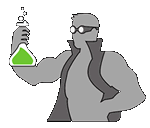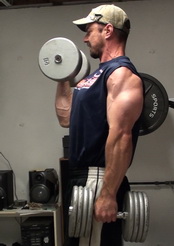20 Single Rep Cluster Training With Anderson Squats
If you want to build a BIG squat, you have to spend time under the bar with heavy weight on your back. You also have to learn how to ENJOY the bottom position of the exercise...or at the very least, not be afraid of it. Because in the case of the squat, what goes down doesn't necessarily have to come up...
|
This technique is called Single Rep Cluster Training...and the exercise we'll be doing it with will be Bottom Start Squats (a.k.a. Anderson Squats).
Starting out of the bottom from a dead stop is GREAT for developing power out of "the hole" (as the bottom position is known). It removes all elastic energy from the muscles, forcing them to actually DO all the work of the squat.
When you do a regular top-down squat, as you come to the bottom positon, it's like stretch an elastic band. This gives you some rebound energy when you turn the exercise around and come back up.
This bottom-start exercise takes away all that help, which is what makes it so good for developing a bigger squat FAST. The power you develop in it carries over directly to your "normal" squat strength.
Plus, it teaches you to get comfortable and not be afraid of the bottom position of the squat. Because once you develop the strength for moving the weight with NO elastic help, you'll easily blow up weights that used to be hard.
How to Do Single-Rep Cluster Training for Strength
First off, I want to let you know that you CAN use this Single Rep Cluster technique with the normal squat (and with just about any big compound exercise), however I find in addition to the strength benefits, starting out of the bottom of the squat is faster for setup time because there is not walk-out or re-racking of the bar on each rep. It's just get under the bar and push.
The idea behind Single Rep Cluster Training is to put a lot of volume on an exercise using relatively heavy weights (e.g. 90%+ of your 1 RM) so that your body learns how to move heavy loads and gets PRACTICE moving heavy loads.
This volume of work at those loads also helps develop connective tissue strength specific to the movement you're using so that when you do go to perform maximum-strength lifts, your body is ready for it and won't get injured.
For 20 reps of Single Rep Cluster Training (which is what I would recommend), use about 90% of your 1 RM for the exercise. You can do other rep ranges with this style of training as well...I've just found 20 reps to be the sweet spot in terms of volume vs %1RM weight used.
Set the safety rails of the rack to about waist height. Starting from the bottom will take a little getting used to, so go lighter than you think you'll need the first time you do this one, then build up from there.
Set your feet under the bar in your normal squat stance position then get yourself under the bar and get it locked into position on your back.

Now comes the fun part. Develop tension in the quads, hamstrings and glutes and POWER the bar off the rails.
Don't "pop" the bar up...imagine as though the bar is stuck to the rails with glue...and you have to develop tension and push until the glue releases. This is a similar concept to pulling a bend into the bar with deadlifts (in this case, you're pushing a bend into the bar with your back).

Continue the movement. Once you pass the sticking point, accelerate the bar all the way up to the top position. The bar will move fairly slow up until that point, especially with heavier loads. The key is to TRY and move it fast in order to active all possible motor units at once for maximum power development.

Once you've finished the lift, lower the bar down under control and set it back down on the rails. Don't just drop down...this should still be a controlled descent at the same pace you normally would keep as if you were doing a full squat back up.
Now get out from under the bar and rest for 20 seconds. You'll do this for 20 total reps for the "set."
This rest period of 20 seconds is enough time to achieve substantial recovery of the ATP-PC energy (the powerful "fast-acting" energy system of the body) while still maintaining the targeted nervous system activation of the previous rep.
Ironically enough, you will likely find with this technique that your first rep is your "worst" rep in terms of form and power generation. As you do more reps, your body will find the groove for the exercise and learn how to generate peak power on that specific movement pattern. Within a few reps, the exercise will feel better.
Reps 5 through 15 will generally be your best in terms of form. Once you hit about 15 reps, then fatigue will start to turn the reps into grinding reps. You're still not hitting failure, but it takes real effort to get the rep done.
This one "set" of 20 single reps takes about 10 minutes to get through and then you'll be done with squats.
I like to set my timer for a 15 minute block of time then just let it count down, so I can visually see what the timer says when I finish one rep and when I have to start the next one. That way, I don't have to manually start the timer or stop it.
Use Single-Rep Cluster Training just once a week...it's intense and once a week is plenty.
The way I like to do it is to work the "big 3" exercises all on the same day...squats, bench press, deadlifts....using this 20-rep cluster training method. Then that's it for the day.
Overall, Single Rep Cluster Training is incredibly effective for developing very specific strength and nervous system efficiency with heavy loads. And using it with the Bottom Start Squat will get your squat numbers up FAST by attacking the weakest phase of the exercise.
---
Are you 40...50...60 or even 70+ years old and want to build muscle and strength like you did 20 years ago?
If you feel like you're fighting a losing battle, you're ready to discover the REAL secret to REVERSING muscle loss due to aging...
*** You need to train the body systems that SUPPORT your muscle mass, not just the muscle itself. ***
These underlying support systems diminish as you age, which is why you lose muscle as you get older no matter how hard you train... but with strategic training, these systems can be regenerated.
Share This Page...
Want More Strength-Building Techniques and Programs?
You'll find them here...
- Return to PRIME - Reset Your Muscle Clock Back 20 Years
- Time-Volume Training - Build Muscle and Strength Like Clockwork
- Muscle Explosion - 28 Days to Maximum Mass
Get 14 Free "Mad Scientist" Workouts Here!
It's like the 12 Days of Christmas with AWESOME training instead of birds...



